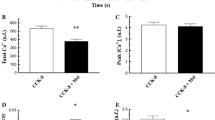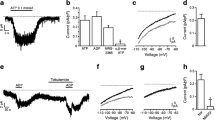Abstract
In pancreatic acinar cells, as in many other cell types, the tumour promoter thapsigargin (TG) evokes a significant increase of intracellular free Ca2+ ([Ca2+]i). The increases of [Ca2+]i evoked by TG was associated with significant changes of plasma membrane Ca2+ permeability, with [Ca2+]i values following changes in extracellular [Ca2+]. Plasma membrane Ca2+ extrusion is activated rapidly as a consequence of the rise in [Ca2+]i evoked by TG and the rate of extrusion is linearly dependent on [Ca2+]i up to 1 μM Ca2+. In contrast, the activation of the Ca2+ entry pathway is delayed and the apparent rate of Ca2+ entry is independent of [Ca2+]i. In the presence of 20 mM caffeine, which reduces the resting levels of inositol trisphosphate (InsP3), the increase of [Ca2+]i evoked by TG was significantly reduced. The reduction was manifest both as a decrease of the amplitude of the [Ca2+]i peak (30% reduction) and, more importantly, as a reduction of the apparent maximal rate of [Ca2+]i increase (from 12.3±1.0 to 6.1±0.6 nM Ca2+/s). The inhibition evoked by caffeine was reversible and the removal of caffeine in the continuous presence of TG evoked a further increase of [Ca2+]i. The amplitude of the [Ca2+]i increase upon caffeine removal was reduced as a function of the time of TG exposure. Addition of TG in the presence of 1 mM La3+, which is known to inhibit the plasma membrane Ca2+-activated adenosine triphosphatase, induced a much higher peak of [Ca2+]i. This increase was associated with an augmentation of the apparent rate of [Ca2+]i increase (from 12.3±1.2 to 16.1±1.9 nM Ca2+/s). The inhibitory effect of caffeine, as well as the increase in [Ca2+]i observed on caffeine removal was not affected by the presence of 1 mM La3+. These data indicate that an important component of the TG-evoked [Ca2+]i increase is due to InsP3-sensitive Ca2+ release which is probably mediated by the resting levels of InsP3.
Similar content being viewed by others
References
Berridge MJ (1993) Inositol trisphosphate and calcium signalling. Nature 361:315–325
Bezprozvanny I, Watras J, Ehrlich BE (1991) Bell-shaped calcium-response curves to Ins(1,4,5)P3- and calcium-gated channels from endoplasmic reticulum of cerebellum. Nature 351:751–754
Donnadieu E, Bismuth G, Trautmann A (1992) Calcium fluxes in T lymphocytes. J Biol Chem 267:25864–25872
Endo M (1977) Calcium release from the sarcoplasmic reticulum. Physiol Rev 57:71–108
Foskett JK, Roifman CM, Wong D (1991) Activation of calcium oscillations by thapsigargin in parotid acinar cells. J Biol Chem 266:2778–2782
Glennon MC, Bird GSJ, Kwan C-Y, Putney JW (1992) Actions of vasopressin and the Ca2+-ATPase inhibitor, thapsigargin, on Ca2+ signalling in hepatocytes. J Biol Chem 267:8230–8233
Gouy H, Cefai D, Christensen SB, Debre P, Bismuth G (1990) Ca influx in human T lymphocytes is induced independently of inositol phosphate production by mobilization of intracellular Ca2+ stores. A study with thapsigargin. Eur J Immunol 20:2269–2275
Heemskerk JWM, Vis M, Feijge MAH, Hoyland J, Mason W, Sage SO (1993) Roles of phospholipase C and Ca2+-ATPase in calcium responses of single, fibrinogen-bound platelets. J Biol Chem 268:356–363
Hoth M, Penner R (1992) Depletion of intracellular calcium stores activates a calcium current in mast cells. Nature 355:353–356
Jackson TR, Patterson SI, Thastrup O, Hanley MR (1988) A novel tumor promotor, thapsigargin, transiently increases cytoplasmic free Ca2+ without generation of inositol phosphates in NG 115-401L neuronal cells. Biochem J 253:81–86
Kwan C-Y, Takemura H, Obie JF, Thastrup O, Putney JW (1990) Effects of MeCh, thapsigargin, and La3+ on plasmalemmal and intracellular Ca2+ transport in lacrimal acinar cells. Am J Physiol 258:C1006-C1015
Llopis J, Chow SB, Kass GEN, Gahm A, Orrenius S (1991) Comparison between the effects of the microsomal Ca2+-translocase inhibitors thapsigargin and 2,5-di-(t-butyl)-1,4-benzohydroquinone on cellular calcium fluxes. Biochem J 277:553–556
Lytton J, Zarain-Herzberg A, Periasamy M, MacLennan DH (1989) Molecular cloning of the mammalian smooth muscle sarco(endo)plasmic reticulum Ca2+ATPase. J Biol Chem 264:7059–7065
Menniti FS, Bird GSJ, Takemura H, Thastrup O, Potter BVL, Putney JW (1991) Mobilization of calcium by InsP3 from permeabilized rat parotid acinar cells. J Biol Chem 266:13646–13653
Missiaen L, Taylor CW, Berridge MJ (1991) Spontaneous calcium release from inositol trisphosphate-sensitive calcium stores. Nature 352:241–244
Osipchuk YV, Wakui M, Yule DI, Gallacher DV, Petersen OH (1990) Cytoplasmic Ca2+ oscillations evoked by receptor stimulation, G-protein activation, internal application of inositol trisphosphate or Ca2+: simulataneous microfluorimetry and Ca2+ dependent Cl− current recording in single pancreatic acinar cells. EMBO J 9:697–704
Otun H, Gillespie JI, Greenwell JR, Dunlop W (1991) Inhibition of Ca2+ mobilization by caffeine in a cultured vascular smooth muscle cell line (A7R5). Exp Physiol 76:811–814
Parker I, Ivorra I (1991) Caffeine inhibits inositol trisphosphate-mediated liberation of intracellular calcium in Xenopus oocytes. J Physiol (Lond) 433:229–240
Parys JB, Missiaen L, DeSmedt H, Droogmans G, Casteels R (1993) Bell-shaped activation of InsP3-induced Ca2+ release by thimerosal in permeabilized A7r5 smooth-muscle cells. Pflügers Arch 424:516–522
Pickles RJ, Cuthbert AW (1992) Failure of thapsigargin to alter ion transport in human sweat gland epithelia while intracellular Ca2+ concentration is raised. J Biol Chem 267:14818–14825
Roche S, Bali J-P, Magous R (1993) Receptor-operated Ca2+ channels in gastric parietal cells: gastrin and carbachol induce Ca2+ influx in depleting intracellular Ca2+ stores. Biochem J 289:117–124
Rooney TA, Renard DC, Sass EJ, Thomas AP (1991) Oscillatory cytosolic calcium waves independent of stimulated inositol 1,4,5-trisphosphate formation in hepatocytes. J Biol Chem 266:12272–12282
Rowley WH, Sato S, Huang SC, Collado-Escobar DM, Beaven MA, Wang L-H, Martinez J, Gardner JD, Jensen RT (1990) Cholecytokinin-induced formation of inositol phosphates in pancreatic acini. Am J Physiol 259:G655-G665
Takemura H, Hughes AR, Thastrup O, Putney JW (1989) Activation of calcium entry by the tumor promoter thapsigargin in parotid acinar cells. J Biol Chem 264:12266–12271
Tao J, Haynes DH (1992) Actions of thaspigargin on the Ca2+-handling systems of the human platelet. J Biol Chem 267:24972–24982
Tepikin AV, Voronina SG, Gallacher DV, Petersen OH (1992) Acetylcholine-evoked increase in the cytoplasmic Ca2+ concentration and Ca2+ extrusion measured simultaneously in single mouse pancreatic acinar cells. J Biol Chem 267:3569–3572
Thastrup O, Dawson AP, Scharff O, Foder B, Cullen PJ, Drobak BK, Bjerrum PJ, Christensen SB, Hanley MR (1989) Thapsigargin, a novel molecular probe for studying intracellular calcium release and storage. Agents Actions 27:1–2
Thorn P, Brady P, Llopis J, Gallacher DV, Petersen OH (1992) Cytosolic Ca2+ spikes evoked by the thiol reagent thimerosal in both intact and internally perfused single pancreatic acinar cells. Pflügers Arch 422:173–178
Toescu EC, Lawrie AM, Petersen OH, Gallacher DV (1992) Spatial and temporal distribution of agonist-evoked cytoplasmic Ca2+ signals in exocrine acinar cells analysed by digital image microscopy. EMBO J 11:1623–1629
Toescu EC, O'Neill SC, Petersen OH, Eisner DA (1992) Caffeine inhibits the agonist-evoked cytosolic Ca2+ signal in mouse pancreatic acinar cells by blocking inositol trisphosphate production. J Biol Chem 267:23467–23470
Wakui M, Osipchuk YV, Petersen OH (1990) Receptor-activated cytoplasmic Ca2+ spiking mediated by InsP3 is due to Ca2+-induced Ca2+ release. Cell 63:1025–1032
Wolff T, Leipziger J, Fischer KG, Klar B, Nitschke R, Greger R (1993) Evidence for agonist-induced export of intracellular Ca2+ in epithelial cells. Pflügers Arch 424:423–430
Zhang BX, Zhao H, Loessberg P, Muallem S (1992) Activation of the plasma membrane Ca2+ pump during agonist stimulation of pancreatic acini. J Biol Chem 267:15419–15425
Author information
Authors and Affiliations
Rights and permissions
About this article
Cite this article
Toescu, E.C., Petersen, O.H. The thapsigargin-evoked increase in [Ca2+]i involves an InsP3-dependent Ca2+ release process in pancreatic acinar cells. Pflügers Arch 427, 325–331 (1994). https://doi.org/10.1007/BF00374541
Received:
Revised:
Accepted:
Issue Date:
DOI: https://doi.org/10.1007/BF00374541




